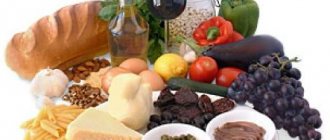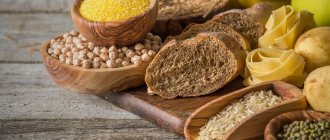What are carbohydrates
It is one of three types of macronutrients, or substances that nourish the body.
The other two are fats and proteins. Carbohydrates are divided into classes:
- Sugars are individual sugar molecules or short chains of such molecules. These are glucose, fructose, galactose, sucrose.
- Starches are long chains of carbohydrate molecules that are broken down into small components in the digestive tract.
- Fiber is carbohydrates that are not digested.
The main function of carbohydrates is to provide energy to the body. Most of them break down in the digestive tract to glucose, which then serves as fuel. Each gram of carbohydrates provides 4 kcal. The exception is fiber, which is much lower in calories.
What to remember: Carbohydrates are nutrients that provide energy.
What about carbohydrates?
A carbohydrate is made up of carbon and water. Thanks to them, a person receives the energy necessary to maintain the vitality of the body. When 1g is split, 17.6 kJ of energy is released.
With insufficient carbohydrate intake, the breakdown of proteins and fats begins, which leads to the accumulation of toxins. Also sugar:
- Ensures the functioning of the brain, kidney tubules, and eyeball.
- They participate in the synthesis of complex proteins and components of the immune system, as well as other substances necessary for the functioning of the body.
- Ensure normal functioning of the heart, nervous system, muscle tissue, liver and digestive system.
- Regulates the processes of protein and fat metabolism.
Most foods contain carbohydrates. Eggs, meat, fish and seafood may contain a minimum amount. Dairy products contain lactose.
There are four types of substances:
- Monosaccharides. They are not able to break down into simpler ones. These include glucose and fructose.
- Disaccharides. These are complex compounds of two monosaccharide residues. For example, lactose, sucrose.
- Oligosaccharides. They contain residues of several monosaccharides (no more than 10). For example, beet raffinose.
- Polysaccharides. The most complex connections. They are formed from a large number of glucose residues. They are divided into digestible (starch) and non-digestible (fiber).
What foods contain carbohydrates:
- Sugar, honey
- Drinks with added sugar: juices, compote, tea, coffee.
- Alcoholic drinks.
- Flour dishes: muffins, cakes, bread, buns.
- Pasta.
- Fruits, herbs and vegetables.
- All types of cereals.
- Nuts, seeds.
- Legumes: beans, peas, lentils.
- Dairy products: milk, kefir, fermented baked milk, cottage cheese.
Thus, the list of carbohydrates includes a fairly large number of food products, but not all of them are equally valuable.
Why not all carbohydrates are created equal
Figuring out how many carbohydrates you need is not easy because they are different. Most often, carbohydrates are divided into simple and complex. The former include sugars, and the latter include starches and fiber.
But this classification can be problematic because foods high in starch can be both beneficial and harmful to health (especially refined, processed grains).
In addition, sugars act differently Dietary sugars and cardiometabolic risk: systematic review and meta-analyses of randomized controlled trials of the effects on blood pressure and lipids on the body. Sugar that is specifically added to baked goods or drinks is harmful. But natural sugars from fruits and vegetables don't have any health-wrecking effects. So the definitions of complex and simple carbohydrates need to be clarified.
- Complex carbohydrates are carbohydrates from unprocessed foods, including fruits, beans, and whole grains.
- Simple carbohydrates are sugars and starches that have been removed from fiber and processed.
What to remember: Complex carbohydrates are found in unprocessed foods. Simple carbohydrates with less nutritional value are processed.
Your carbohydrate needs
To function fully, our bodies need carbohydrates, especially glucose, which the body prefers to use to fuel tissues and internal organs - and is the only source of energy for red blood cells. When the body does not have enough carbohydrates, the body begins to use protein from the muscles and organs to create glucose.
The recommended daily allowance of carbohydrates is 130 g. This is the minimum necessary for the health of the brain, red blood cells and central nervous system. Without getting enough energy, you risk losing muscle mass, which your body will spend on creating glucose. 130 g is the minimum for adults. Most people need more. According to American experts, 45-65 percent of the energy from your daily calorie intake should come from carbohydrates. This percentage difference is due to the fact that each organism is individual and there is no single approach that is ideal for everyone.
The approximate daily intake of carbohydrates should be 50% of the number of calories in your daily diet, but this is an average figure that we advise you to change depending on your goals.
How to determine your daily requirement?
- Decide what percentage of protein you need and convert it to a decimal (for example, 50% - 0.5)
- Multiply your daily calorie intake by that number to get the number of calories you need from carbohydrates.
- Divide this number by 4 to get your desired amount of carbohydrates in grams.
Calculator
What is the difference between carbohydrates
Complex carbohydrates are healthier than simple carbohydrates because they have higher nutrient density. That is, along with every calorie, they supply the body with antioxidants, fiber, vitamins and minerals. But simple carbohydrates are just calories and nothing more.
To understand what the difference is, let’s compare whole grains with refined grains. There are three parts to a whole grain:
- The germ is the part of the grain that is high in polyunsaturated fats and other nutrients.
- Endosperm is the inner part of the grain, which consists mainly of starch.
- The hull is the hard outer part of the grain, which is high in fiber and essential fatty acids.
In the germ and shell (bran) there is everything that is best, healthy and nutritious. But during processing, the shell and embryo are removed, so that only the starchy endosperm remains.
Compare how many nutrients are contained in 120 g of whole and refined wheat grains.
| Whole grain | Refined grain | |
| Calorie content, kcal | 407 | 455 |
| Carbohydrates, g | 87 | 95,4 |
| Proteins, g | 16,4 | 12,9 |
| Fats, g | 2,2 | 1,2 |
| Fiber, g | 14,6 | 3,4 |
| Thiamine, % of daily value | 36 | 10 |
| Riboflavin, % of daily value | 15 | 0 |
| Niacin, % Daily Value | 38 | 8 |
| Vitamin B6, % of daily value | 20 | 8 |
| Folic acid, % of daily value | 13 | 8 |
| Vitamin B5, % of daily value | 12 | 5 |
| Iron, % of daily value | 2 | 8 |
| Magnesium, % of daily value | 41 | 7 |
| Phosphorus,% of daily value | 42 | 13 |
| Potassium, % of daily value | 14 | 4 |
| Zinc, % of daily value | 23 | 6 |
| Manganese, % of daily value | 228 | 43 |
| Selenium, % of daily value | 121 | 61 |
| Choline, mg | 37,4 | 13 |
Whole wheat grain is a source of essential substances that are lost during cleaning and processing.
The same is true with fruits and vegetables. Fresh ones contain sugars, but also vitamins, minerals and fiber. But processed, cooked (especially semi-finished products) and even squeezed vegetables contain more sugar and less nutrients. In addition, sugar is often added to prepared foods and drinks.
What to remember: Complex carbohydrates, such as whole grains and fresh fruits and vegetables, are nutritious. Simple carbohydrates have more calories but fewer nutrients.
Simple carbohydrates, their sources and consumption rates
Monosaccharides
Glucose, grape sugar
The main source of energy for the cells of the human body. Glucose in its pure form is found in grapes, fruits, honey, and dried fruits. Glucose is the end product of the breakdown of complex carbohydrates in the body. Glycemic index of glucose = 100. The consumption rate for a healthy person is considered to be 2.6 g. per 1 kg of body weight.
Fructose, fruit sugar
Organoleptically sweeter than glucose, while its glycemic index is 20. Quite a lot is found in honey and fruits. Worse to ferment. Fructose immediately goes directly to the liver; if we eat too much fructose, we risk having fatty liver hepatosis. The maximum fructose intake is considered to be 25 grams per day, but people with metabolic syndrome, a tendency to develop gout, joint disease or obesity should consume no more than 15 grams of pure fructose per day. Eating large amounts of fructose, up to 50 grams per day, can cause metabolic syndrome.
Study
: Fructose and sugar: A major mediator of non-alcoholic fatty liver disease
There are many studies proving that fructose is a predisposing factor in the development of fatty liver and metabolic syndrome.
Galactose, milk sugar
It is a component of lactose. Found in sugar beets, tomatoes and some fruits. It is independently synthesized in the body and is a component of cell wall membranes. There is quite a lot of it in the brain. In high concentrations, galactose becomes toxic, there is a genetically determined pathology of the enzyme system, when a person is not able to metabolize, that is, process galactose, lactose, this is all associated with a violation of the lactose cycle.
Oligosaccharides
Sucrose, cane or beet sugar
Glycemic index 70. Sucrose consists of two monosaccharide molecules, glucose plus fructose. It is believed that the harm of white table sugar is largely not due to glucose, but precisely because half of it is fructose. Quite a lot is contained in honey, dried fruits, dates. Sucrose promotes the formation of free radicals. . If consumed in excess, it can lead to nutritional deficiencies, displaces copper, chromium, and B vitamins from the body, promotes aging, and the development of age-associated diseases.
Lactose, milk sugar
Consists of glucose and galactose. Glycemic index (GI) is about 46. Lactose is quite easily transformed into adipose tissue and can be used as an energy substrate and stimulates the growth of lactic bacteria in the intestines. Since dairy products appeared in the human diet relatively recently, approximately 8,000 years ago, some peoples have a fairly high percentage of lactose intolerance.
Maltose, malt sugar
Consists of two glucose molecules. Contained in sprouted grains, it is used in the production of fermented drinks such as beer. They are quite rich in B vitamins.
What are the benefits of complex carbohydrates?
Does not cause sudden spikes in blood sugar
Simple carbohydrates are digested quickly, and because of this, blood sugar rises sharply. Jumps in sugar levels cause the pancreas to produce large doses of insulin, and this already leads to a sharp drop in sugar. When there is little of it in the blood, we want to eat again Effects of dietary glycemic index on brain regions related to reward and craving in men - we reach for a new portion of something tasty.
Complex carbohydrates rich in fiber are digested more slowly. Sugars from them enter the blood gradually, which means that jumps do not occur Whole Grains, Legumes, and the Subsequent Meal Effect: Implications for Blood Glucose Control and the Role of Fermentation. Therefore, complex carbohydrates provide energy to the body evenly, helping to keep you feeling full longer.
Reduce the risk of chronic diseases
Complex carbohydrates, when consumed regularly, reduce Association between dietary whole grain intake and risk of mortality: two large prospective studies in US men and women the risk of chronic diseases such as diabetes or cardiovascular disease. All because of the fiber, vitamins and other substances discussed above: they help Critical review: vegetables and fruits in the prevention of chronic diseases in prevention.
Moreover, studies have shown Insoluble carob fiber rich in polyphenols lowers total and LDL cholesterol in hypercholesterolemic sujects that consuming complex carbohydrates reduces the amount of “bad” cholesterol in the blood and increases the amount of “good” cholesterol.
Helps digestion
The intestines are home to billions of beneficial bacteria called microbiota. It affects not only the health of the intestines, but the entire body. Fiber from complex carbohydrates is food for beneficial bacteria. The better you feed them, the better they work, such as producing nutrients like short-chain fatty acids, which are important Review article: prebiotics in the gastrointestinal tract. for the health of the gastrointestinal tract.
Reduce inflammation
Inflammation is the body's natural response to infection or injury. If the process is delayed, it provokes Inflammation, pain, and chronic disease: an integrative approach to treatment and prevention of the development of many serious diseases, including cancer and diabetes.
Complex carbohydrates help fight The effects of diet on inflammation: emphasis on the metabolic syndrome with inflammation, but simple sugars, on the contrary, support it.

If parents want to raise a healthy child, they should know what carbohydrates are for a child, what they are, what foods they contain, and how they affect the child’s body.
Someone argues that carbohydrates are an absolute evil and that foods containing them should be excluded from the diet, choosing a carbohydrate-free diet to improve your health. According to another opinion, it is impossible to live without carbohydrates, since they are necessary to maintain full functioning. But it's one thing when it comes to recommendations for adults. But are they suitable for kids? Do parents need to transfer their habits, even the most scientifically correct ones, to their child’s nutrition?
Carbohydrates are a source of energy
Carbohydrates are primarily nutrients, most often of plant origin. Once in the body, they become a source of energy, which is stored in the form of glucose, which the hormone insulin, if necessary, helps deliver to the cells of tissues and organs. This way their activity is maintained.
A lack of carbohydrates leads to disruption of metabolic processes in the body and general exhaustion. Doctors warn that such experiments cause a deterioration in the child’s well-being. Outwardly, this manifests itself as decreased activity, often even apathy, and emotional imbalance and depression. In addition, the liver, which acts as a natural filter, becomes clogged with keto acids, which leads to a deterioration in its performance.
Carbohydrates are so different...
Scientists divide all carbohydrates into simple and complex. Alternatively, they are known as fast and slow - thereby indicating the period of time over which certain carbohydrates are absorbed. Complex (slow) are polysaccharides. But simple (fast) carbohydrates are also not so simple, since they are divided into monosaccharides and disaccharides. And they are the sweetest of all carbohydrates.
Fruits, berries, vegetables, honey and even milk contain fast carbohydrates. Their easy digestibility and attractive taste create problems in the nutrition of children. The fact is that with excessive consumption of sweets, the production of insulin in the body increases significantly, which leads to a decrease in blood sugar levels. In this situation, the child constantly feels tired and hungry, and becomes inattentive.
You also need to keep in mind that simple carbohydrates are quickly absorbed not only by humans, but also by bacteria living in the oral cavity. The result is tooth decay, as these bacteria actively produce acid, which destroys the enamel. In addition, the balance of acidity in the stomach and intestines is disrupted, which can cause diarrhea. The absorption of other elements important for a growing body slows down, and the risk of diabetes increases. And all this is due to an excess of simple carbohydrates in the body!
But complex carbohydrates are absorbed slowly, so the body receives the necessary energy gradually over a long time. This is mainly starch and fiber found in some vegetables, grains and cereals.
Complex carbohydrates also include fibers that are not digested, but nevertheless benefit the body because they help remove toxins and lower blood sugar levels, which improves the microflora in the intestines, and generally helps strengthen the immune system.
However, oversaturation with them is also dangerous, as this can provoke the development of obesity in a child.
A Smarter Approach to Carbohydrates
Doctors do not approve of eliminating all carbohydrates from baby food. You just have to remember that they make up a very diverse group of foods, which includes grains and potatoes, peas and pasta, fruits and juices, milk and sugary drinks.
All carbohydrates provide calories, but the right choice of carbohydrates also provides the child’s body with vitamins, minerals, and dietary fiber. Examples of these nutrient-rich carbohydrates include whole grain products, both bread and pasta, as well as cereals, brown rice, potatoes, fruits, and legumes.
White bread, noodles and white rice are another group of foods that are sources of carbohydrates. But in the process of purification or refining, they lost many plant fibers and other nutrients necessary for the child. Particular caution should be exercised when sweet drinks, sweets, cakes, and cookies appear on the toddler’s menu. Chocolate and strawberry milk are certainly tastier than regular milk, but you shouldn’t get carried away with it either, because it additionally contains sugar.
An example for the baby
Don't forget to set an example for your children every day of how to eat well. Even the most observant child will not notice a substitution on the plate if you create a pleasant atmosphere for a family meal, if you strive for variety in culinary matters using healthy products.
In general, complex carbohydrates can and should be on the table every time you feed your baby. Variations from potatoes, pasta, rice in combination with other products that the toddler loved even during the introduction of complementary foods will give you ample opportunities to turn complex carbohydrates into his favorites.
And if the shelves in your kitchen are full of cookies and chocolate, if older children and adults endlessly rustle with candy wrappers, and there is always a box of cake in the refrigerator, then the baby will make a choice in favor of these harmful sweets. Therefore, try not to buy them for future use, do not stock up so as not to expose the baby to temptation. Also, you should not make sweets a “forbidden” fruit, because in this case the child will strive to receive them constantly. Let there be treats at home, but only healthy ones and in moderation. For example, they produce marshmallows and fruit-based marshmallows, which can be served in small quantities for dessert after dinner.
Remember that the development of good and bad habits in children can be controlled. Let's all choose only healthy food together!
Our expert
Natalya Grishina, pediatrician, gastroenterologist, Ph.D.
Problems with obesity in children do not appear out of the blue. If your house is filled with “bad” or “healthy” foods, it is you who buy them at the store, and this affects your children’s eating habits. Train yourself to eat healthy foods and avoid brightly colored packages of chips and sweets.
Learn to serve cooked food beautifully; now you can find a lot of examples of how you can put ordinary vegetables and cereals on a plate. Don't use sweets as a reward for your child's good behavior or as a consolation for stress.
When organizing your child’s meals, opt for complex carbohydrates. Moreover, you don’t have to introduce them specifically into your baby’s daily diet, because the champions in complex carbohydrates are bread, rice, potatoes, and pasta.
Dark varieties of rice, whole grain products and products made from wholemeal flour saturate the body with energy more slowly and, accordingly, keep the feeling of fullness longer. And the same foods, but “white” ones, are broken down too quickly in the gastrointestinal tract, causing a jump in blood sugar levels, causing instant satiety and an equally quick return of hunger.
If parents want to raise a healthy child, they should know what carbohydrates are for a child, what they are, what foods they contain, and how they affect the child’s body.
Someone argues that carbohydrates are an absolute evil and that foods containing them should be excluded from the diet, choosing a carbohydrate-free diet to improve your health. According to another opinion, it is impossible to live without carbohydrates, since they are necessary to maintain full functioning. But it's one thing when it comes to recommendations for adults. But are they suitable for kids? Do parents need to transfer their habits, even the most scientifically correct ones, to their child’s nutrition?
Carbohydrates are a source of energy
Carbohydrates are primarily nutrients, most often of plant origin. Once in the body, they become a source of energy, which is stored in the form of glucose, which the hormone insulin, if necessary, helps deliver to the cells of tissues and organs. This way their activity is maintained.
A lack of carbohydrates leads to disruption of metabolic processes in the body and general exhaustion. Doctors warn that such experiments cause a deterioration in the child’s well-being. Outwardly, this manifests itself as decreased activity, often even apathy, and emotional imbalance and depression. In addition, the liver, which acts as a natural filter, becomes clogged with keto acids, which leads to a deterioration in its performance.
Carbohydrates are so different...
Scientists divide all carbohydrates into simple and complex. Alternatively, they are known as fast and slow - thereby indicating the period of time over which certain carbohydrates are absorbed. Complex (slow) are polysaccharides. But simple (fast) carbohydrates are also not so simple, since they are divided into monosaccharides and disaccharides. And they are the sweetest of all carbohydrates.
Fruits, berries, vegetables, honey and even milk contain fast carbohydrates. Their easy digestibility and attractive taste create problems in the nutrition of children. The fact is that with excessive consumption of sweets, the production of insulin in the body increases significantly, which leads to a decrease in blood sugar levels. In this situation, the child constantly feels tired and hungry, and becomes inattentive.
You also need to keep in mind that simple carbohydrates are quickly absorbed not only by humans, but also by bacteria living in the oral cavity. The result is tooth decay, as these bacteria actively produce acid, which destroys the enamel. In addition, the balance of acidity in the stomach and intestines is disrupted, which can cause diarrhea. The absorption of other elements important for a growing body slows down, and the risk of diabetes increases. And all this is due to an excess of simple carbohydrates in the body!
But complex carbohydrates are absorbed slowly, so the body receives the necessary energy gradually over a long time. This is mainly starch and fiber found in some vegetables, grains and cereals.
Complex carbohydrates also include fibers that are not digested, but nevertheless benefit the body because they help remove toxins and lower blood sugar levels, which improves the microflora in the intestines, and generally helps strengthen the immune system.
However, oversaturation with them is also dangerous, as this can provoke the development of obesity in a child.
A Smarter Approach to Carbohydrates
Doctors do not approve of eliminating all carbohydrates from baby food. You just have to remember that they make up a very diverse group of foods, which includes grains and potatoes, peas and pasta, fruits and juices, milk and sugary drinks.
All carbohydrates provide calories, but the right choice of carbohydrates also provides the child’s body with vitamins, minerals, and dietary fiber. Examples of these nutrient-rich carbohydrates include whole grain products, both bread and pasta, as well as cereals, brown rice, potatoes, fruits, and legumes.
White bread, noodles and white rice are another group of foods that are sources of carbohydrates. But in the process of purification or refining, they lost many plant fibers and other nutrients necessary for the child. Particular caution should be exercised when sweet drinks, sweets, cakes, and cookies appear on the toddler’s menu. Chocolate and strawberry milk are certainly tastier than regular milk, but you shouldn’t get carried away with it either, because it additionally contains sugar.
An example for the baby
Don't forget to set an example for your children every day of how to eat well. Even the most observant child will not notice a substitution on the plate if you create a pleasant atmosphere for a family meal, if you strive for variety in culinary matters using healthy products.
In general, complex carbohydrates can and should be on the table every time you feed your baby. Variations from potatoes, pasta, rice in combination with other products that the toddler loved even during the introduction of complementary foods will give you ample opportunities to turn complex carbohydrates into his favorites.
And if the shelves in your kitchen are full of cookies and chocolate, if older children and adults endlessly rustle with candy wrappers, and there is always a box of cake in the refrigerator, then the baby will make a choice in favor of these harmful sweets. Therefore, try not to buy them for future use, do not stock up so as not to expose the baby to temptation. Also, you should not make sweets a “forbidden” fruit, because in this case the child will strive to receive them constantly. Let there be treats at home, but only healthy ones and in moderation. For example, they produce marshmallows and fruit-based marshmallows, which can be served in small quantities for dessert after dinner.
Remember that the development of good and bad habits in children can be controlled. Let's all choose only healthy food together!
Our expert
Natalya Grishina, pediatrician, gastroenterologist, Ph.D.
Problems with obesity in children do not appear out of the blue. If your house is filled with “bad” or “healthy” foods, it is you who buy them at the store, and this affects your children’s eating habits. Train yourself to eat healthy foods and avoid brightly colored packages of chips and sweets.
Learn to serve cooked food beautifully; now you can find a lot of examples of how you can put ordinary vegetables and cereals on a plate. Don't use sweets as a reward for your child's good behavior or as a consolation for stress.
When organizing your child’s meals, opt for complex carbohydrates. Moreover, you don’t have to introduce them specifically into your baby’s daily diet, because the champions in complex carbohydrates are bread, rice, potatoes, and pasta.
Dark varieties of rice, whole grain products and products made from wholemeal flour saturate the body with energy more slowly and, accordingly, keep the feeling of fullness longer. And the same foods, but “white” ones, are broken down too quickly in the gastrointestinal tract, causing a jump in blood sugar levels, causing instant satiety and an equally quick return of hunger. Source: https://mamaexpert.ru/article/polza-i-vred-uglevodov-dlya-rebenka Discuss in the forum -
Why are simple carbohydrates harmful?
To be healthy, eat little complex carbohydrates. We must also give up simple ones, because they:
- Provoke overeating. Simple carbohydrates are quickly digested and lead to spikes in blood sugar levels. This causes a constant feeling of hunger.
- Increase the risk of heart attacks and strokes. Studies have shown the Potential role of sugar (fructose) in the epidemic of hypertension, obesity and the metabolic syndrome, diabetes, kidney disease, and cardiovascular disease, that people who frequently eat simple carbohydrates are more likely to develop heart and vascular diseases.
- Increases the risk of developing type 2 diabetes. Frequent consumption of simple carbohydrates can Fructose, insulin resistance, and metabolic dyslipidemia make cells resistant to the action of insulin. This is the cause of the development of type 2 diabetes.
- Lead to sugar addiction. Sugar stimulates the brain to produce dopamine. People who are prone to addictions can become addicted to sweets.
- Increase weight. Simple carbohydrates affect the level of hormones responsible for appetite, and in such a way that the risk of obesity increases. High glycemic index foods, overeating, and obesity.
Metabolism of carbohydrates in the body
Understanding the metabolism of carbohydrates - the main fuel of cells (especially in the context of a traditional type of nutrition) is the key not only to predicting certain metabolic disorders, but also an important element in the formation of a holistic picture of the disease.
So, as previously mentioned, all complex carbohydrates undergo enzymatic breakdown (to a lesser extent under the action of salivary amylase and maltase, and to a greater extent due to the work of pancreatic and intestinal enzymes) and are absorbed by the villi of the epithelium of the small intestine. The path of simple sugars is much simpler: their molecules are already represented by structural units, which means they are quickly absorbed and easily enter the general bloodstream.
The metabolism of glucose, fructose and galactose - the main representatives of monosaccharides - is quite different from each other. Let's consider some fundamentally important points of their further biotransformation in the human body.
Glucose homeostasis
- one of the iron postulates of the body, the violation of which leads to very unfavorable consequences. So, there are parameters clearly defined by the program for the concentration of this sugar, strictly regulated, first of all, by the endocrine system. In healthy people, as a rule, its level does not fall below 2.5 mmol/l and does not exceed 8 mmol/l after eating food.
The central conductors who have assumed control responsibilities are hormones: insulin and glucagon
. Possessing a polypeptide nature (that is, representing amino acid residues linked by chemical bonds) and formed by the islets of Langerhans, which are located in the pancreas, they perform completely opposite effects.
The task of the first
- reduce the glucose level, which naturally increased after eating, to the optimal level. This is achieved by increasing, under the influence of insulin, the density of a specific glucose transporter (GLUT4) - a protein, which ensures its entry into the cell - in other words, helps to overcome the customs border in the form of the plasma membrane. This process is especially pronounced in muscle and fat tissues. In the latter, it, in addition, includes the mechanism of lipogenesis - that is, it promotes the synthesis of fat (triglycerides).
In addition, in the liver, insulin actively stimulates the formation of glycogen, a reserve substrate that can cover the body’s energy needs for some time during starvation.
Glucagon works differently
: all its effects are aimed at increasing the concentration of glucose in the blood serum. Thus, it activates the mechanism of gluconeogenesis in hepatocytes - the endogenous production of glucose is launched, the raw materials for which can be various non-carbohydrate components: ketone bodies and, in particular, amino acids, obtained mainly through the breakdown of proteins. It also affects key enzymes that regulate glycogen catabolism - the latter is broken down again into glucose.
In stressful situations, new performers join the orchestra of hormones: adrenaline and cortisol
, produced by the medulla and, accordingly, the adrenal cortex. To provide them with the well-known “fight or flight” reaction, it is necessary to mobilize not only the body as a whole, but also to provide it with sufficient energy - the efficiency of glycogenolysis naturally increases (in the case of catecholamines), promoting the breakdown of glucose into pyruvic acid with further oxidation of the latter and the inclusion of the product of complex enzymatic reactions - acetyl-CoA - into the Krebs cycle. Cortisol promotes the formation of key enzymes involved in gluconeogenesis reactions.
The metabolism of fructose is very different: if only because it does not stimulate secretion
from the beta cells of the pancreas
insulin
and partly
thus bypasses the saturation pathways
without affecting the satisfaction of hunger.
Cellular ovens are also unable to utilize it as an energy source - at least without first converting it into glucose. In addition, it can lead to the formation of triglycerides
-
this is the relationship between excess intake of this monosaccharide and the development of non-alcoholic fatty liver disease.
So fruits also make you fat, especially your internal organs.
What to eat and what not to eat
The diet should contain carbohydrates, but only good ones: complex, fresh, unprocessed.
Where to find complex carbohydrates:
- Whole grains: oats, buckwheat, barley.
- Legumes: peas, beans, beans and lentils (not canned).
- Vegetables and fruits: any, preferably fresh or minimally processed.
- Nuts and seeds: hazelnuts, almonds, sunflower seeds, sesame.
Where are simple carbohydrates hidden?
- Sweet drinks: juices, sodas, cocktails, sweet tea and coffee.
- Desserts and sweets.
- White bread made from finely ground wheat flour.
- Pasta: those made from soft wheat.
Complex carbohydrates are more nutritious than simple ones. They have a lot of fiber and nutrients. Therefore, the more often we eat them, the healthier we become. But simple carbohydrates may be tasty, but completely useless and even harmful.
What should be on the menu
Nutritionist Adda Bjarnattodir offered a list of foods rich in healthy carbohydrates. It includes natural foods with a low glycemic index that have not been industrially processed:
- Finished quinoa The grain also serves as a source of protein, so it provides quick and long-lasting satiety;
- oats contain 66% carbohydrates, 11% of which are fiber. It contains beta-glucan polysaccharide, which stimulates the immune system. Research conducted at the University of Sydney showed that this type of carbohydrate promotes weight loss;
- A banana contains 23% starch or natural sugars, which depends on ripeness. Green fruits are rich in insoluble starchy compounds. They stimulate the intestines and help maintain healthy microflora. The benefits were proven by observations conducted at the Brazilian University of Minas Geras by doctors of medicine Alda Leonel and Jacqueline Alvarez-Leite. And if the fruits have turned yellow, then they contain a lot of natural sugars: eat no more than 1 ripe banana per day;
- red beans contain 22.8% insoluble starch and dietary fiber. It contains protein and antioxidants that slow down the aging of the body;
- orange will provide 9 g of healthy carbohydrates. It will serve as a source of both dietary fiber and vitamin C.
Nutritionist Adda Bjarnattodir believes that for proper nutrition it is important not just to eat carbohydrates. She encourages focusing on whole foods with a low glycemic index, and also paying attention to what other substances are contained in the chosen food. The nutritionist reminds us that carbohydrates in natural foods are good for the body.
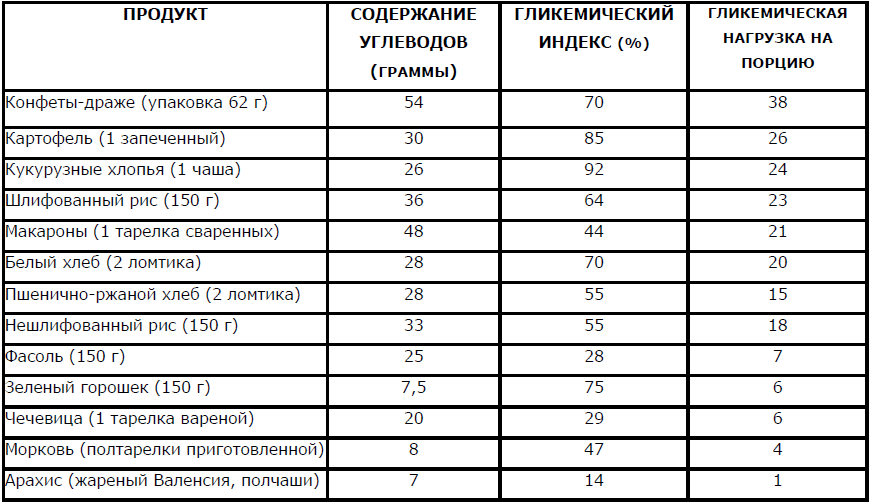
Which foods with carbohydrates are most harmful to your figure: how to replace them
The list of the most harmful foods containing carbohydrates includes the following:
- Coffee has almost no calories, but only until sweet syrups are added to it. Some drinks contain as many monosaccharides as flour desserts with powdered sugar. To avoid gaining weight, switch to Americano or espresso without sweeteners or syrups;

- a piece of white bread gives up to 50 “empty” carbohydrates. To maintain your figure, replace your morning baguette with a bowl of oatmeal;
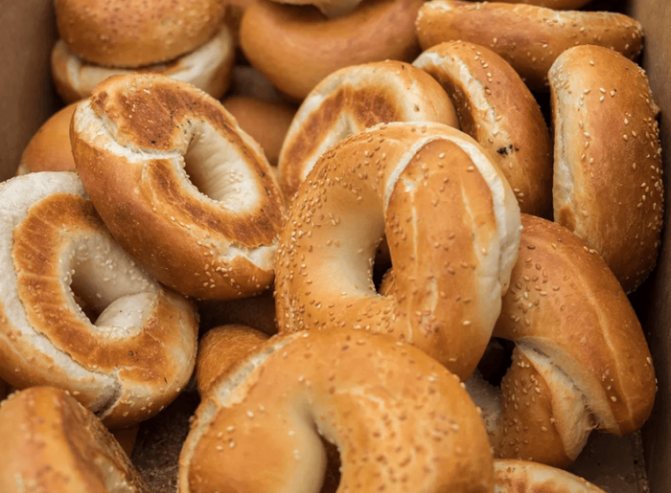
- A 115 g package of store-bought yogurt contains 25 g of carbohydrates, 21 g of which are sugar. Switch to the Greek variety and add pieces of fresh fruit to it;
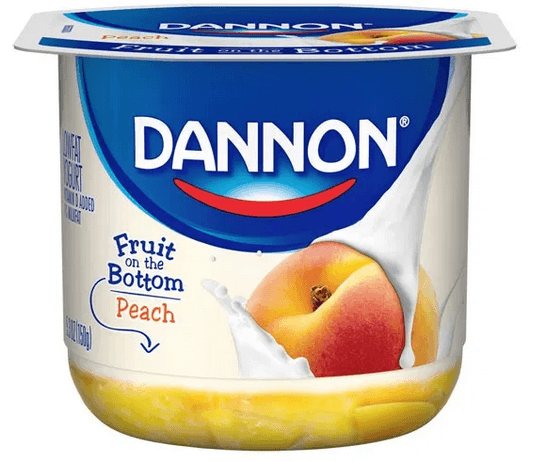
- even 1 tablespoon of jam or marmalade provides 13 g of carbohydrates, of which 12 g are mono- and disaccharides. For an alternative, snack on a slice of whole grain bread with peanut butter in the morning;
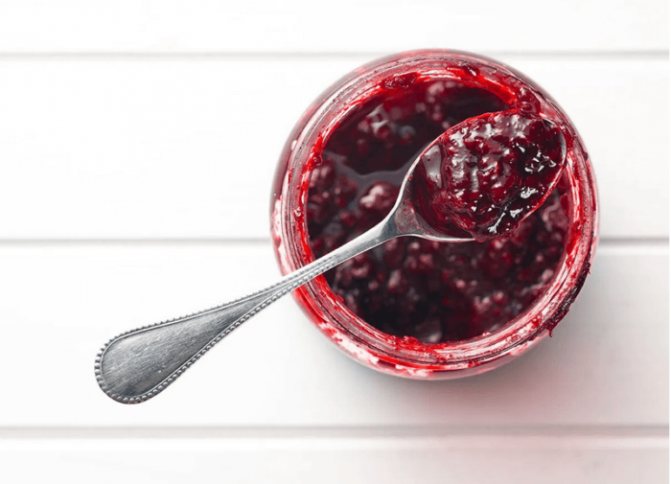
- in a regular glass of beer there are at least 10-20 g of “empty” carbohydrates, which provide only calories.

Please note that simple carbohydrates may be contained even in store-bought products that you consider healthy. Try to replace them with homemade food made from natural ingredients.









